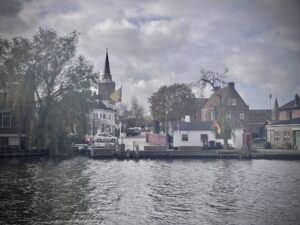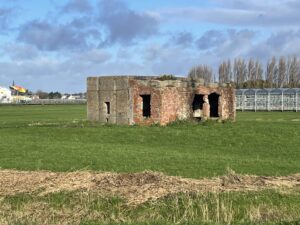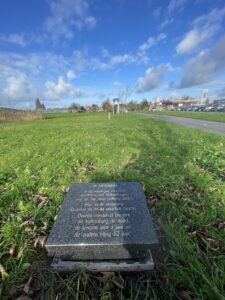Richard Foster surveys thousands of years of history on the banks of the Old Rhine.

Een landverrader! Wat denk je ervan, hèh?
I look down at the plastic card the museum curator has plucked out of a shoe box on his lap, and now holds out to me.
The face on the card, a senior citizen pass from the late 1990s, is that of a bespectacled old man who stares back at the world without any trace of emotion.
By contrast the curator, a senior himself, is shaking with anger. He puts the card back into the box and starts to pull other items out, passing them to us with a distasteful, inquisitorial glance. One artefact takes our breath away: a near-pristine Star of David on yellow cloth, its outlines printed black and with the word Jood printed in the central hexagon.
Accompanying pamphlets — showing images of dark-haired men of shifty appearance with protruding noses and bulbous lips, bent over bags of money — suggest an identifier kit of some sort. They are scattered among a diverse array of clutter; some benign or nondescript, such as postwar photos of family on a nearby beach. Others are obviously less so; cuttings from a paper called Volk en Vaderland and martial badges with a seagull motif catch the eye.
Grabbing my partner’s arm for support, I feel as if all the air has left my lungs.
The curator tells us the box was brought in by a man from Den Haag who had heard that the museum “collected old stuff from the war.” The museum, based in Valkenburg’s new church tower, and looking out over a well-tended official war cemetery, does indeed have a section dedicated to the Second World War and the occupation, and especially the bitter fighting in May 1940, which almost razed the quiet farming village to the ground. Things get dropped off all the time, more out of a desire to clear out clutter than any martial interest, with equipment, rusted ammunition, and worse, still found lying around in the corners of sheds. One spectacular find was on display on the museum’s second floor. A silk German parachute in a display case was a reminder that the church was used as a landmark by the Junkers Ju 52s of the Fallschirmjäger and attracted heavy fire from both sides throughout the subsequent bitter fighting, becoming a prison for the villagers who used it as shelter.

Valkenburg is a peculiar place. A feeling of great antiquity hangs over it. The church, which may have stood here in various forms since the 800s, is at the top of a rising slope of ground that is almost unique in the area. Plaques and foundation markers in the carpark in front of it bear proud witness to the fact that a Roman camp was discovered when the war-battered church tower was knocked down in 1941. Remarkably, this camp is one of three found within a few square kilometres. When the old military airfield began to be excavated for housing in 2020, another huge army camp was found, adding to that of 1941 and another, first detected in 1922. Unsurprisingly, the church museum has a substantial display dedicated to the Romans. You can also catch a ferry over the Old Rhine, said locally to have been active from before Roman times. Ring the buzzer from the small jetty at the far bank and the ferryman will leave his white-daubed riverbank office to fetch you. A ride on the metal flatboat boat costs 70 cents a time, or 5 euros for ten crossings.
The river is wide, and often high here, but fairly placid nonetheless; old brick warehouses and trees from the gardens of modern semi-detached housing developments press close to the banks, with the church visible on the raised ground. Herons, and, increasingly, white egrets fly overhead. If you are lucky to cross on a misty morning, you can feel transported back to an older world, far away from our own. Having alighted, and on your way up the slope to the church, you will pass another signifier of ancient activity. A huge concrete boulder decorating a mini roundabout on the village’s main street has a flattened facade with an attractive if modern pastiche of a Romanesque design, proclaiming Valkenburg to be the location of the Netherlands’ oldest active horse market. It falls on the second Wednesday of each September and is free to visit.
You would think, given all of this, that tourism would play a big part in Valkenburg’s character. And that, like other places, more blatant methods of celebrating and preserving its past would be in order. But this traditionally Dutch Reformed village, on the fringes of the Bollenstreek and the coastal areas, with a main and expanding trunk road to the south and a busy industrial estate demarcating it from neighbouring Katwijk to the north, is not known for its sentiment. It’s as if there is an unspoken understanding that time’s role as the great leveller should not be interfered with. The Wapen van Valkenburg, a grand cafe that could be a tourist trap, has been closed for years. The house plants, standing stoically on the windowsills of its huge conservatory-like front, happily germinate new forms in their pots.
Here, the past turns up in the most humdrum ways. Witness the nearby grey office tower with a swanky restaurant at its base, sat foursquare on the banks of the Old Rhine. It is called Limes; the Latin word for border. Blink and miss the small plaque on a cycle path that commemorates the 11 villagers mown down at this spot, in the crossfire of the terrible battle of May 1940. Next to it is a stark, somewhat abstract monument to the first Roman garrison to be discovered here. Both in view of a busy petrol station, carwash and car sales point. A step or so further down the river you can find the official war memorial to 1940, set back and increasingly framed by tall trees that border the municipal cemetery. On the opposite bank, the perennially busy Haagse Schouw hotel and restaurant caters for a contended middlebrow clientele. You can read the history of the hotel itself, but there is little if any literature to show that this stretch of the Old Rhine has been in constant habitation for four thousand years.

Maybe the only true libation allowed to the past in this small area is the constant digging, something that has been going on here since prehistoric times. New facts emerge as quickly as the place they emerged from disappears. Leiden’s Museum van Oudenheden currently houses a silver bowl, probably Etruscan, that was surmounted with a garnet inlay during the seventh century. The thinking is the bowl, found during other land developments, is proof of this area’s trade with the Kentish kingdoms. It increasingly feels that such riches, and our knowledge and appreciation of them, is a sop of sorts for the rapid recent disappearance, and homogenisation, of the Dutch landscape. A strange sensation arises from cycling round and noting the readjustments to cater for an expanding, often temporary population. Most is driven by the growing city of Leiden and its university; and wider plans to turn the area into a sleeper settlement serving both Leiden and Den Haag. The lapwings, plovers and black tailed godwits that, a decade ago could be regularly seen in the once wide meadowlands and wastelands adjoining the farms, have all but vanished. One local replacement is a wetlands-style theme park, replete with outdoor gym and meandering, rush-lined paths for young families. A well-used stork’s nest is a focal point; nature sculpted to suit the human gaze, the sort of harmonious ordination of the world that Sir Thomas Browne (briefly a Leiden student) would have approved of. Rustic-style wooden huts for local community enterprises, a busy nursery school complex, and the popular FC Valken ‘68’s astroturf pitches are nearby. On the other side of the Leiden-coastal road and heading towards the old airfield, previously forbidden paths to military areas are now accessible. In some places, framed by huge flattened tumps of upturned earth, decrepit old pillboxes and abandoned air control towers squat sullenly in fields populated by rows of greenhouses, silos and corrugated iron sheds. All await an uncertain future.
The visual contrasts with these weather-worn markers and the new cycle paths — made of compound materials, or the rustic timber poles hiding the new road’s junctions — hint of uneasy compromises. All are left to be solved by the incremental forgetfulness encouraged by time. When I last cycled this route, I spied a man in waterproofs fishing under the new concrete underpass, flanked by two enormous yellow diggers. The scene reminded me of those cynical late Edward Burra watercolours of road making in rural England, a depiction of the callous indifference of progress and the mud it creates. Something of the indifference of that fisherman to his surroundings also took me back to that shoebox in the church. What, indeed, is best left unfound?
*
Richard Foster is an artist and writer. He runs the Museum of Photocopies.